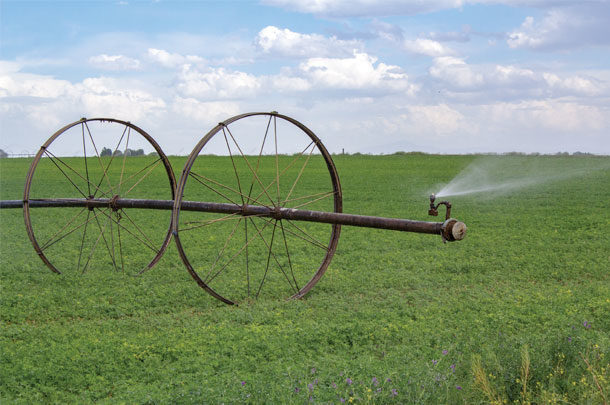Water moves up the plant, carrying nutrients from the soil to growing points. However, the majority of water use by the plant is for cooling on sunny days. The amount of water needed for cooling varies from near zero on a cool, cloudy day to over 0.3 inches per day on a sunny, high-temperature and low-humidity day (0.3 acre-inches equals about 8,146 gallons per acre).
This cooling is crucial because alfalfa photosynthesis increases to about 85 to 90ºF and then begins to decline. Further, respiration (the breaking down of carbohydrates to produce carbon dioxide and energy) increases faster with temperature than photosynthesis (doubling with each 18ºF increase in temperature).
Growth (yield increase) is the difference between photosynthesis (carbohydrate increase) and respiration (carbohydrate loss). Therefore, keeping leaf temperature below 85ºF is crucial to growth. Cool nights with temperatures below 60ºF are also beneficial (due to reduced respiration) but we cannot control this, except by location.
The water needs of alfalfa as a multicut perennial plant differ significantly from annual grain crops. As with all perennial forages, the root system dies back each time the crop is harvested and must regrow for the next crop. Having adequate water in the soil profile when the crop is harvested helps the root system regrow rapidly and results in a greater yield at next harvest.
Root systems also die back going into winter. Therefore, alfalfa needs water in the spring before top growth appears to rebuild root system. Less- than-adequate water in the soil profile during February to April will result in reduced root growth and reduced yield of first cutting 30 to 60 days later.
This is why areas with a dry spring or lack of irrigation have reduced first-cutting yields, even if rain occurs within the 30 days prior to harvest. Loss of first-cutting yield is particularly costly since first cutting generally has the highest yield potential and is usually the highest quality (since it grows in cooler weather conditions).
So let’s use the principles in the preceding three paragraphs to consider the most efficient use of water in irrigation systems.
Soil profile – The first step is to ensure the soil profile is full of water in early spring. This will enhance root growth and first-cutting yield. The soil profile can often be filled with water at this time even if the water flow rate is low because of lack of plant water use and length of time for irrigations.
Water in the soil profile can be used as a reserve later in the season when irrigation cannot keep up with daily water use. Water able to be stored depends on soil texture ranging from about 1.8 inches per 5 feet for sand to 5.5 inches per 5 feet for clay.
First growth – The next step is to attempt to meet full crop water needs on first growth of the season. As stated earlier, first cutting is potentially a high-yielding and high-quality crop. Additionally, the temperatures are generally lower than later in the season, so evapotranspiration is less, and water needed to keep the crop cool is less. These factors mean more yield is produced per unit of water for first-season growth than later in the season.
Water concentration – The next principle is, with limited irrigation water, it is better to concentrate irrigation water on one cutting, going for high yield, than to split limited water among two or more cuttings. By concentrating water on one cutting, more yield is produced per unit of water. Also, there is half the harvesting cost if one higher-yielding cutting is harvested rather than two low-yielding cuttings. Often this principle means first harvest, and possibly second, are irrigated and then fields are allowed to go dormant, depending on rainfall, when there is limited water.
Going into dormancy – Alfalfa can be allowed to go dormant during the growing season due to lack of water. The plant will put out short shoots with flowers. These can be ignored if not economical to harvest (generally less than 10 inches tall) and then, when water becomes available again, new shoots will begin to grow. There is no need to remove the older shoots if there is not sufficient tonnage to harvest economically.
Alfalfa can enter the winter following periods of dormancy and will survive to regrow the next spring; however, some fall irrigation for good root growth will enhance next spring growth.
Maximizing water summary
If irrigation water is limiting, consider concentrating available water on fewer acres. Pick the best fields (good soil, level, weed-free and with good stands). Concentrating water on these fields and letting others go without irrigation will generally increase yield per unit of water.
The above will generally result in the greatest yield with irrigation, even if water is limited. Additional limitations may occur, and modification to irrigation scheduling may be needed with sprinkler systems due to soil-water infiltration rate and with surface irrigation systems due to seasonal water availability.
The above will result in the highest yield relative to water availability assuming that soil fertility is adequate (a soil or tissue test is strongly recommended). Also, consider that each ton of alfalfa removes 50 pounds potassium and 5 pounds sulfate. These may need to be replaced annually if yield is to be maintained.
Yield is also maximized, even with limited irrigation, if insects and diseases are controlled or at least mitigated.
Remember, forage yield is determined by the first limiting factor. It is crucial to eliminate or at least reduce the limiting factors other than water to maximize the yield per unit of water. ![]()
PHOTO: With limited water, it’s better to concentrate irrigation on one cutting than to split limited water among two or more cuttings. Photo by Lynn Jaynes.

-
Dan Undersander
- Forage Professor Emeritus
- University of Wisconsin











